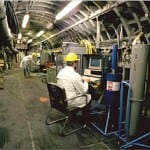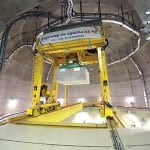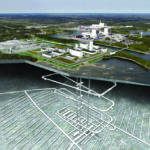Construction of a $310 million repository about 250 meters below Earth’s surface for low- and intermediate-level radioactive waste from the operation and future decommissioning of Hungary’s power plants reached a significant milestone at Bataapati. Inaugural ceremonies for the National Radioactive Waste Repository (Figure 4) were held last December, opening the first disposal chamber that will hold 4,600 drums of radioactive waste in 510 reinforced concrete containers. More chambers are to be built to eventually accommodate 40,000 cubic meters of waste.
 |
| 4. Burying waste. Hungary’s National Radioactive Waste Repository at Bataapati, a facility that will eventually hold all low-level and intermediate radioactive waste from the country’s four nuclear power plants, was inaugurated in December. Courtesy: PURAM |
The facility is being built by the Public Limited Company for Radioactive Waste Management (Radioaktív Hulladékokat Kezelo Kft., RHK Kft), formerly the Public Agency for Radioactive Waste Management (PURAM). The state-owned body carried out site investigations for more than 10 years before finally focusing on building the repository in granite in the south of the country. The government accelerated licensing of the facility in 2006, and surface facilities for the repository were opened in October 2008.
Hungary has four nuclear reactors that generate about 43% of its power (about 30% is generated with gas, 18% with coal, and the remainder is imported from its neighbors, mainly Slovakia). All four of its reactors, housed at the Paks Nuclear Power Plant, are Russian-designed VVER-440s that first generated power in the 1980s. Paks Units 2, 3, and 4 are scheduled to be closed between 2014 and 2017 (though the Hungarian Parliament has approved 20-year extensions for all the units). Paks 1’s license was extended to 2032.
The March 2009 approval for a new nuclear plant by the Hungarian Parliament has prompted Paks to consider building two new 1-GW reactors at the Paks site. A decision is expected this year, and possible contenders for the tender are AREVA’s EPR, the Atmea1, Atomstroyexport’s VVER-1000, Westinghouse’s AP1000, and South Korea’s APR-1400.
According to the International Atomic Energy Agency, at the end of 2010, a global radioactive waste inventory reported that there were approximately 61.4 million m3 of short-lived, low- and intermediate-level waste (LILW–SL), 13.9 million m3 of long-lived, low- and intermediate-level waste (LILW–LL), and 423,000 m3of high-level waste (HLW). Disposal facilities for low-level waste were operational or under construction in several countries, including Belgium, Bulgaria, the Czech Republic, France, India, Japan, Lithuania, Norway, Romania, Slovakia, Spain, and the UK.
A LILW disposal complex similar to the one at Bataapati is under construction at Gyungju, in the Republic of Korea. That facility began in 2010 accepting the first 1,000 drums of waste from the twin-reactor Ulchin nuclear plant for outdoor storage until the $730 million underground repository can be commissioned in mid-2014. The completed repository is expected to have a number of silos and caverns about 80 meters below the surface with an initial capacity of about 100,000 drums.
—Sonal Patel is POWER’s senior writer.










